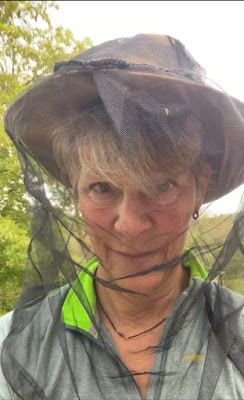 |
| Do you really want to go there? |
I had a guest from Cambridge, Massachusetts a few weeks ago who told me how to avoid getting bitten by mosquitos. Which I was complaining about. I needed to get a Thermacell electric repellant that kept mosquitos at a distance of 15 feet! I know she felt I was being dismissive when I said “Hah! Not a chance!” After a day or two she pretty much got where I was coming from.
Mosquitos breed in standing water. Everybody knows that. What do you do when every couple of days there’s standing water, like, everywhere? Locally there have been about twenty-two inches of rain in July and August. That doesn’t even count September which has been producing more of the same. And now that it’s well into that month, and almost past time for those mosquitos to quit biting, many of their predators are gone, too. Where are those dive-bombing swallows when you need them! Why schedule such an early departure when there’s so much to eat right here? Come on!
You think maybe I’m exaggerating?
 |
| Lesley, ready for hostilities, i.e., going outdoors |
The little white square above was intended to be a short video of Chris in similar anti-mosquito gear, but shown with mosquitos. []Alas, it stubbornly refused to load.]
Anyway, here’s the real dirt about mosquitos. They won’t stop biting until it cools off – being cold-blooded creatures – meaning a number of 50 degree days in a row. So, they can stick around until October. Or maybe into October. Apparently, by that time they are active in the day rather than the night. Big deal. Right now of course it’s 24/7.
Can I tell you now about the crickets? A banner year! According to the Vermont Center for Ecostudies in Norwich, Vermont:
“Because they overwinter as nymphs Spring Field Crickets hatch in early spring and mature enough to mate and begin their singing by late spring. They continue singing and mating until late June or early July, when they finish laying their eggs and die off.”
They are not, I repeat, not, dying off.
In the lawn you might notice crickets as well as grasshoppers, not unusual for late summer. It’s when they congregate that you can appreciate how many there really are. My pool is one of those popular places. Crickets like to hang out on the “critter rescue” pad on one side of the pool, the idea being that, let’s say, frogs that jump into the pool will swim around trying to escape (realizing, perhaps, that it’s not a real pond) and will eventually arrive at the pad where a ramp will lead them out.* For crickets, however, it functions more like their diving platform because, honestly, that’s how they use it. They hop on, and jump into the pool. Eventually, when I’m around to rescue them – the small ones get rescued by hand, but the big crickets call for the net – they will sink to the bottom. As for the newly rescued, more likely than not, back in they go.
 |
| Deceased crickets in the skimmer basket, 4 inches deep. |
Now, about the plants!
This year I made a new raised bed closer to the house than the old beds that were ridiculously far away. The harvest this wet summer has been amazing. Basil seedlings turned into little shrubs, parsley into bouquets, tomatoes in to a bounty, and cucumbers – they were kinds of odd.
 |
| So many tomatoes. This is my third batch, two having already been frozen, and at least that many eaten in salads and sauces. |
 |
| A bumper crop at my local farm and supplier of eggs: they're giving them away! |
Along with everything else, my cucumber plants were thriving. The baby cucumbers looked promising. Early on one turned green and looked to be the right size for picking, and I gave it away, expecting to have many more than I could even eat. The remaining baby cucumbers were white and stayed white as they grew. I waited for them to turn green. But they were still white, frustratingly white. I waited some more. Then they blew up like some weirdly mutated thing. I know zucchinis can turn giant, especially when you haven't been paying attention, but cucumbers? I figured I’d eat one anyway, but it didn't have any taste. I harvested only a single, perfect, green cucumber.
 |
| My giant, white, tasteless cucumbers |
And the field! The wildflowers in mid-summer were prolific and beautiful. I was glad there wouldn't be mowing until August. But August came and went without a window of dry weather for cutting, drying and baling. Many fields around here were hayed, but the season was a poor one for almost all farmers because of so much wet. Every farm has wet areas. My field has a damp section, a swale, right in the middle. It still hasn’t been mowed, and I have no idea when it might be.
 |
| The grasses grow, and keep growing. |
* When the pool was new, and before I installed the critter rescue pad, I came upon a garter snake desperately trying to get out. I saw it throw the top part of itself over the lip, but there was too much weight behind the front part to pull itself out, so it kept swimming around the perimeter. I tried to grab it with the skimmer but that only terrified the snake, so I finally had to use my hands and lift it out. It was time to put the rescue pad to use.